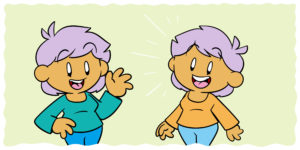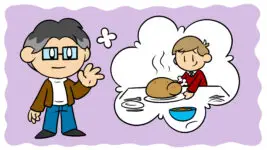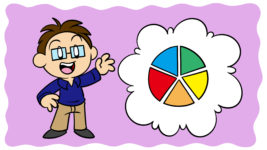When it comes to writing a book that grabs the reader, authors need every tool possible. This is especially true when getting into the minds of your characters, where it can be easy to miss the key to unlocking their potential. That’s why, in this article, I’ll be taking a look at deep point of view: what it is, where it comes from, and how you can use it.
What is deep point of view?
Beth Hill of The Editor’s Blog explains, “Deep POV is a fairly new option for writers. It’s only become popular in the last 20–40 years, but it’s made itself strongly known and keenly felt… much of current fiction is written using this viewpoint.”
Deep point of view is a technique that tears down the wall between the reader and the point-of-view character. It aims to remove every obstacle standing in the way of the reader experiencing everything the character experiences. Take a look at these sample passages:
Third-person point of view:
Molly heard her mother’s voice booming from downstairs, calling her in that particular way she did whenever she was angry. What had she done wrong this time, Molly wondered. She felt the ache in her stomach rise with every word.
“Get down here NOW!” her mother screeched.
Don’t make me, Molly prayed. She couldn’t bear her mother’s enraged face, but she knew it would be so much worse if she ignored her.
Third-person deep point of view:
A sound shattered the silence. Mom’s voice booming up the stairs. A loud and angry wave coming straight for her.
What did I do?
The familiar pain started in her stomach, twisting into a knot with every word.
“Get down here NOW!”
Don’t make me, please. It was always the same. Her mother’s bulging eyes, and the flush creeping up her neck, the shaking hands that balled into fists. The knot squeezed in her gut.
But it would be so much worse if she ignored her.
Compare the third-person point of view to the deep point of view version. How does each passage make you feel? Does deep point of view draw you more powerfully into Molly’s world?
Deep point of view tears down the wall between the reader and the point-of-view character.Click To TweetThere are several aspects of writing deep point of view that account for the difference:
- Limiting tags with dialogue and internal thought,
- Avoiding filter words like heard, felt, watched,
- Replacing the narrator’s voice with the character’s voice,
- Showing over telling.
Using deep point of view in your writing
Doing a bit of work beforehand can help writing in deep point of view become more natural. Because it involves intimate connection with your point-of-view character, you need to get to know them.
I’m talking about going beyond a character’s desires, goals, fears, and motives. In order to write in your character’s authentic voice – not the objective and removed voice of the narrator – you need to be acquainted with their worldview and beliefs, the phrases that run on a loop in their mind, the metaphors they use to make sense of their experiences, the lens through which they see the world. In the most extreme form of deep point of view, you’re writing as the character; the narrator disappears almost entirely.
Writing in deep POV means knowing the bones of your characters.Click To TweetOnce you feel you’re ready to write as your character, give it a shot. Channel that point-of-view character, and put pen to paper. It’s hard at first; you might not realize how comfortable you are in the role of narrator, but with practice, you’ll get the hang of it.
Using deep point of view as you write allows you to lean back into your intuition, to feel when the moment is right to go deeper. But if you find you just really struggle to write new scenes in the style of deep point of view, an alternative is to rewrite passages in that style during your revision stages. The advantage to this approach is that you’re able to be more intentional about which scenes should implement this tool.
Knowing the limits of deep point of view
Unlike other approaches to point of view, deep point of view – in most cases – should not be used consistently throughout the story. I hope you noticed from the sample passage that this tool makes a scene more intense, more immediate. It’s supposed to do that, but imagine reading an entire book in deep point of view. You’d be emotionally exhausted by the end!
Deep point of view is emotionally tiring, so save it for moments that justify the effort. Click To TweetUse deep point of view with intention, picking and choosing scenes that are best served by this close-up view. How long and how often you use this tool is up to you; the point is, be discerning.
One thing to note is that there are degrees of depth with this tool. If you don’t go quite as deep, you could write in deep point of view much longer without taxing the reader. Say, for example, you remove filter words and tags but still write in the narrator’s voice, backing away from the character’s voice. That is not as deep a perspective and is thus more sustainable over time.
My point is that this is a flexible, versatile tool. Play with it, test its range, explore the possibilities. Whatever you do, do it on purpose.
Deep point of view is modular; you can take what you like and leave the rest. Click To TweetHarnessing your writer’s toolkit
Connecting with readers is such a thrill. What author doesn’t love to hear that their book sucked us in, kept us on the edge of our seats, and had us reading into the early hours of the morning? But this level of writing takes work. Few authors can create this with ease, and sometimes, it feels like that elusive X factor is always just out of reach. But writing compelling fiction is within your grasp! Go back to your writer’s toolkit and develop your craft. With every new tool you hone, your writing will become more powerful. Start using deep point of view today and you’re guaranteed to get readers more engaged.
What tips help you write powerful, deep-point-of-view scenes? Which aspect of deep point of view is hardest for you to master? In the comments, tell us about the most recent page-turner you read and how it used deep point of view. You can also check out Your Complete Guide To Writing Perspective: Who, When, How and Struggling To Connect To Your Characters? Interview Them.






10 thoughts on “Everything You Ever Wanted To Know About Deep Point Of View”
Hi Paige,
I have drafted a historical novel set 2,000 years ago.
I put my first draft aside over a year ago as I was not and am still not happy with the voice in the story. Recently I stumbled on the notion of Deep POV. This sounds right for a novel redraft but my MC is not in every scene.
The first draft is mainly 3rd person omnipresent and perhaps for that, it is not as lively as I would like.
If my MC takes on the deep POV I envisage, how do I cater for the scenes which he is not in?
Thank you for an excellent article
Cheers,
Paul
Hi Paul,
Your project sounds very interesting! Unfortunately, the nature of Deep POV puts it at the opposite end of the spectrum from an omniscient narrator in terms of narrative distance. As you said, an omniscient narrator creates scenes that are “not as lively.” That’s because the narrator sees all, knows all, and can report anything–meaning there is a lot of narrative distance between the reader and the characters and events of the story. By contrast, Deep POV aims to create almost no narrative distance; it takes readers right inside the experiences, thoughts, and feelings of the character(s). I think it would be incredibly challenging, if not impossible, to successfully use Deep POV with an omniscient narrator simply because they are inherently so different in their degree of narrative distance.
You could experiment with rewriting the book in multiple third person instead of third omniscient. This would allow you to use Deep POV in multiple scenes with multiple characters. Or you could stick with the omniscient narrator, but take a tighter approach, decreasing narrative distance as much as possible within that framework. I find this article (http://theeditorsblog.net/2016/07/19/deep-pov-and-narrative-distance-part-1/) to be very helpful in explaining the idea of narrative distance in regard to Deep POV.
I hope you find this helpful! And I’m sorry I don’t have better news for you about marrying omniscient narration with Deep POV. I wish you all the best as you work toward your next draft!
Paige
Am I right in thinking that deep POV can morph into present tense?
I can see that happening when an author switches from the past tense narration to the character’s internal thoughts, which would be written in present tense. I’m not sure how else that might happen, though. Can you send me an example?
Paige
I am writing a scene that takes a rest from the action and focuses on my characters building relationship. I am experimenting with deep pov in this scene. I have a section where I want a character to feel a flood of different emotions at the same time. I am lost at how to do this. Her clothes are dirty so she is a little yucked out. She also feels building attraction to another. She is feeling shy, but screams at herself to be bold! These are contradictory, and without tags, I admit that I’m am lost.
Hi Matt,
This does sound like a tough scene to craft! A couple suggestions come to mind that might help light your way forward:
1. Put yourself in the character’s shoes. As much as possible, put yourself inside her experience, play out or act out the scene as if you were her. How do you experience this moment? What do you feel, see, hear, smell, taste inside that moment? What thoughts run through your/her mind? This is the essence of deep POV–you want to put readers inside the experience, so if you can write it from that place, you’ll have an advantage.
2. Consider honing in on a few key emotions. I like the idea that this character is flooded with emotion. Who hasn’t experienced a moment like that? But if you find that you just can’t navigate your way through this scene, consider scaling it back a bit. Another advantage of deep POV is that it allows you to go, well, deep into a moment, and sometimes that means quality over quantity.
I hope these ideas will help to get you started. Best of luck!
Paige
Paige I need help with character movements when in deep pov, particularly stuff like: She got up, she sat down, sitting down, running over to him, she back away, stuff like that Is there a better way to do this?
Am I doing this right? :
The midday sun was unrelenting. He plopped down on a stump, and then pulled off a boot to rub his aching blister covered feet. It was bad, awful, black luck is what it was. The goddess statue cracking like that! Picking it up again he frowned. It’s once smooth surface wrecked by deep cracks. It was no wonder the crops were drying up. She didn’t take well to her image marred, no, not at all.
A woman screamed; echoed far off ahead shattered the quiet of the forest; a second one came—it was closer now—ringing louder with each second.
Parcival stood and repressed a shout.
No, better wait and see.
A pounding of hoofs nearby.
Over there?
Maybe I’m over thinking things I just worry that it isn’t really deep pov. Thank you for any help. This article was helpful and I bookmarked it. <3
Hi Paige..
Thank you for this content, it is excellent.
Just a quick question. You say “deep point of view – in most cases – should not be used consistently throughout the story”, so Deep Pov should just be included or added in certain places?
As in, I’m just about to begin writing a multiple character historical novel and I was planning on using third person POV limited, are you suggesting I would stick to this plan but add in some Deep POV?
Thank you.
Stephen
It took a while but i finally get this, it just became too exhausting trying to to every damn word in deep pov; madness! It’s goo to re-read this again.
Hi Page,
I’ve enjoyed this article on Deep POV written in 2018. Have you written any more since?
I’m struggling with how to open the first scene in my story from the POV of the protagonist and to indicate her name, as well as her situation in the setting.
How can i do that?
First person present Eg my name is Mary Baxter and I’m sitting at my parents 1910 Panloa nervous about my future.
Third person past Mary Baxter sat at her pat1910 Planola stressed about her future.
What I can’t figure out is how to open the first scene in deep POV with protagonist name, feelings and what she sees in the right sequence.
Any suggestions would be DEEPLY appreciated.
What I can’t figure out is